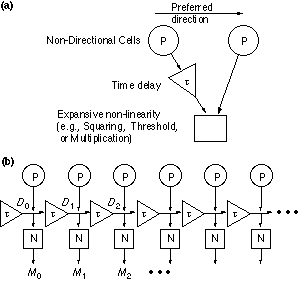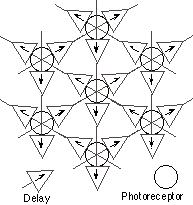2-d motion chip
This page holds a paper about a 2-d analog motion chip.
T. Delbrück. (1993). Silicon retina with Correlation-Based, Velocity-Tuned Pixels. IEEE Transactions on Neural Networks, Vol. 4, No. 3, pp. 529–541.
- MPEG movie: This movie shows the
response of the motion chip to a set of bars moving in the 3 different
principal directions of the hex array. When the motion starts and stops,
note how the predicted image features build up and keep going. Note how
the output in a non-principal direction results in a combination of the
outputs from the principal directions.
- MPEG movie: This movie shows the response of the chip to radial motion, produced by a spinning spiral pattern.
In this paper, I discuss a two-dimensional silicon retina that computes
a complete set of local direction-selective outputs. The chip motion
computation uses unidirectional delay lines as tuned filters for moving
edges. The motion computation is based on the Reichardt correlation
detector, but has been extended to over a wider spatial and temporal
range, as shown here: 
Photoreceptors detect local changes in image intensity, and the outputs
from these photoreceptors are coupled into the delay line, where they
propagate with a particular speed in one direction. If the velocity of
the moving edges matches that of the delay line, then the signal on the
delay line is reinforced. The output of each pixel is the power in the
delay line signal, computed within each pixel. This power computation
provides the essential nonlinearity for velocity-selectivity. Here is
what part of the circuit within each pixel looks like: 
The delay line architecture differs from the usual pairwise correlation
models in that motion information is aggregated over an extended
spatiotemporal range. As a result, the detectors are sensitive to motion
over a wide range of spatial frequencies.
In two dimensions, I have used a hexagonal architecture, as shown here: 
The directional tuning at a particular spatial frequency and speed of
the three outputs from a pixel look like this: 
In response to some moving patterns, the chip output which is displayed
on a monitor in real time, looks like this: 
I have designed and tested functional one- and two-dimensional silicon
retinas with direction-selective, velocity-tuned pixels. A
velocity-selective detector requires only a single delay element and
nonlinearity for each tuned velocity, and is sensitive to both light and
dark contrasts. The use of adaptive photoreceptors and compact circuits
makes for a well-conditioned input signal and small circuit offsets,
resulting in robust operation. All circuits work in subthreshold,
resulting in low power consumption. Pixels with three hexagonal
directions of motion selectivity are approximately (225 µm)^2
area in a 2-µm CMOS technology, and consume less than 5 µW
of power.
Some of the circuits used in this pixel are described in papers.
The receptor circuits are discussed here. The
antibump nonlinearity circuit is discussed here.
The scanner used to visualize the activity of this (and other) chip(s)
is discussed here.
Ron Benson, Carver Mead, and I developed a related (or complementary) approach that uses null-inhibition instead of correlation to make directive selective, velocity-tuned responses.
Tobi Delbruck
September 13, 2007




